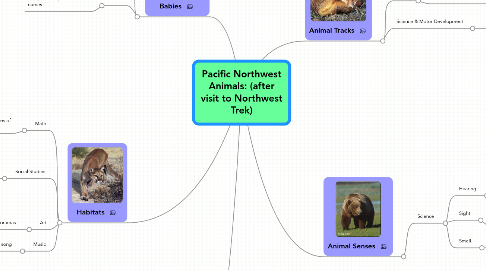
1. Babies
1.1. Literacy
1.1.1. Book: Northwest Animal Babies
1.1.1.1. How do they change as they grow? Compared to us?
1.1.1.1.1. Graph the height of each animal
1.1.1.1.2. Social Studies
1.2. Math
1.2.1. animal cards: sorting babies and parents by pictures and names
2. Animal Coats
2.1. Science
2.1.1. Fur
2.1.1.1. Bears, Wolves, Fox, etc.
2.1.1.2. Otters
2.1.1.2.1. Need their fur clean or else they can't float on water.
2.1.2. Feathers
2.1.2.1. Bald Eagles
2.1.2.2. Ducks & Swans
2.1.2.2.1. Produce oil to keep their feathers from getting wet, to keep them warm
2.2. Social Studies
2.2.1. Similarities between how they use their coats to how we use our skin and clothing.
2.2.1.1. Need to keep dry to stay warm
2.2.1.2. Keep clean
2.2.1.3. water repellent
3. Habitats
3.1. Math
3.1.1. Graph: What are some homes of animals we know?
3.1.1.1. Literacy
3.1.1.1.1. Book: Where Do I Sleep?
3.2. Social Studies
3.2.1. Why they pick their homes?
3.2.1.1. Food availability
3.2.1.1.1. Each child picks a NW animal and brings to class an example of what that animal eats. (picture, actual food, etc.)
3.2.1.2. Stay dry
3.2.1.3. Safety
3.2.1.4. Weather
3.3. Art
3.3.1. habitat dioramas
3.3.1.1. each child picks an animal and makes the habitat of that animal in their own box with a picture of the animal.
3.3.1.1.1. put up around room
3.4. Music
3.4.1. "We're going on a bear hunt" song
4. Animal Tracks
4.1. Math
4.1.1. Measuring size of each animal's footprint
4.1.1.1. Art
4.1.1.1.1. Comparing our footprints with size of animal tracks using paint
4.2. Science & Motor Development
4.2.1. Look for animal tracks
4.2.1.1. Place different tracks around room and have groups follow and show at end of tracks what animal they found.
5. Animal Senses
5.1. Science
5.1.1. Hearing
5.1.1.1. Deer
5.1.1.1.1. experiment of cupping ears with hands to hear better in front
5.1.2. Sight
5.1.2.1. Close eyes and using your other senses figure out by pointing where I am
5.1.2.1.1. This is how nocturnal animals like raccoons, owls, etc. "see" in the night.
5.1.3. Smell
5.1.3.1. bear
5.1.3.1.1. 2,100 times better than a human's
